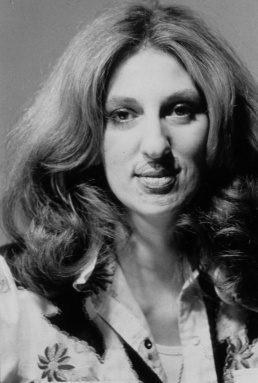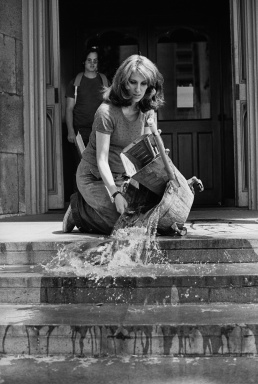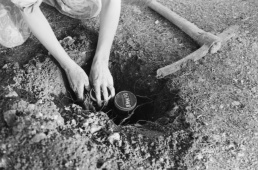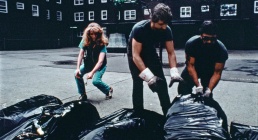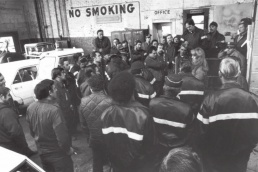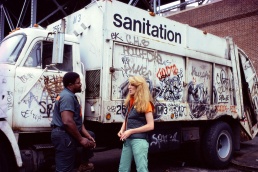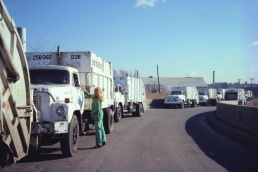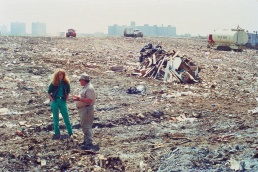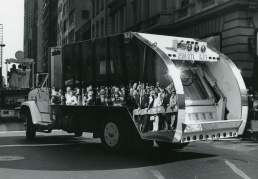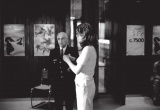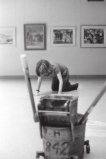Mierle Laderman Ukeles
Mierle Laderman Ukeles (1939, Denver, Colorado) is a New York City-based artist.
Since 1977, Ukeles has acted as the official, unsalaried artist-in-residence at the New York City Department of Sanitation (DNSY) and realised radical public art as public culture in a system which serves and is owned by the entire population.
Works
The work of Ukeles concerns the everyday routines of life. In 1969, Ukeles wrote her Manifesto for Maintenance Art as a challenge to the oppositions between art and life, nature and culture, and public and private. Her work looked to highlight otherwise overlooked aspects of social production and questions, still very relevant today, the hierarchies of different forms of work, especially of housework and low-wage labour. Ukeles was interested in how artists could use the concept of transference to empower people to act as agents of change and stimulate positive community involvement toward ecological sustainability. [1]
"I am an artist. I am a woman. I am a wife. I am a mother. (Random order). I do a hell of a lot of washing, cleaning, cooking, renewing, supporting, preserving, etc. Also, (up to now separately) I 'do' Art. Now I will simply do these everyday things, and flush them up to consciousness, exhibit them, as Art."
(Ukeles, Manifesto for Maintenance Art, 1969).
Engaged with ecology and the city since the 1960s, Ukeles fabricated inflatable sculptures and wearables in organic shapes in Air Art (1967-69). These were meant to be attached to existing buildings or serve as independent architecture for individuals and groups. After use, they were supposed to be deflated, folded, and put away. With their ease of function, they were to be symbols of freedom. But their manufacture, care, and maintenance was so complex that they, along with the birth of her first child, ended up triggering Manifesto for Maintenance Art 1969!
Ukeles’ contribution to curator Lucy Lippard’s 1973 exhibition of feminist conceptual art, c. 7500, included the picture album Maintenance Art Tasks, 1973, and recorded interviews with people about their maintenance habits. The work explores the complexity, duration, and choreography of daily maintenance activities by documenting them in detail: hair cuts, doctors visits, changing diapers, and washing dishes among others. The numerous images of a single activity indicate the extended time span that maintenance requires. c. 7500’s traveling venues provided Ukeles an opportunity to test more than a dozen Maintenance Art Performances, based on the principles of her Manifesto. Along with washing its steps, Ukeles intervened in the Wadsworth Athenaeum’s security and conservation systems, raked and tracked falling leaves on the campus of Vassar College, scrubbed a Soho sidewalk, and more. These performances illuminated fundamental structures of institution and society, and the hidden power of those who maintain it.
An important leap came in 1976, when Ukeles invited 300 maintenance workers at a downtown office building to consider one hour of their eight-hour work shift to be Maintenance Art. She then took Polaroids of them and asked whether, in their opinion, her camera had captured them during their hour of art, or their seven hours of work. I Make Maintenance Art One Hour Every Day, 1976, includes 704 original Polaroids labeled with each workers’ decision. When a Village Voice review of the piece suggested, tongue-in-cheek, that the Sanitation Department—suffering like the rest of New York City from a fiscal crisis—call its work performance art and apply for funds from the National Endowment for the Arts, Ukeles enclosed the clipping in a letter to the Commissioner of Sanitation, and a career-changing partnership was born.
In the performance Maintaining NYC in Crisis: What Keeps NYC Alive? (1976), Ukeles reads the job titles of those in municipal bureaucracies threatened by the city’s impending bankruptcy but necessary to keep the the city functioning, a recitation that can be read as both a living memorial and a declarative protest.
Ukeles’ first performance with the New York City department of sanitation (DSNY) was Touch Sanitation Performance, 1979-1980, in which she faced and shook the hand of all 8,500 Sanitation employees as they did their work, saying to each, “Thank you for keeping New York City alive.” Engaging in public space, Touch Sanitation humanizes this alienating work and conveys the importance of a traditionally devalued sector of labor. As the project progressed, she also documented the stories of these workers in the video Sanman Speaks (1979-84), providing a space for the workers to articulate their own positions and experiences. The video also records the complex and durational process of collecting and disposing of waste, giving a sense of the physical immensity of society’s refuse. [2]
Since 1983, Ukeles has staged seven Work Ballets, 1983-2012, in five cities around the world, working with the drivers of heavy-duty municipal vehicles to co-design delightful performances in which their work trucks and barges are the dancers. Her first work ballet, Social Mirror, 1983, is a garbage truck clad in mirror created as part of Sanitation Celebrations.
Ceremonial Arch IV, 1988/1993/1994/2016, was first created in 1988 for an exhibition at the World Financial Center titled Ceremonial Arch for Service Workers in a New Service Economy. The work is a celebration of the hands and enduring spirits that keep New York City functioning. A “harvest” of 5,000 of used, signed work gloves from workers at New York’s Fire, Police, Sanitation, Environmental Protection, Parks, Cultural Affairs, and Transportation Departments; the Metropolitan Transit Authority; and ConEdison sprout in a leafy canopy over six sturdy columns wrought out of the tools of the trade of some of the same municipal agencies and the United States Postal Service.
Since the start of her tenure at DSNY, Ukeles has envisioned landfills as new public spaces—earthworks that we ourselves have made and own. In Inner City Outer Space: Landfills and Transformation, 1977-ongoing, a range of proposals and artworks from nearly 40 years of work were displayed together for the first time in 2017 on five walls surrounding Queens Museum’s central sky-lit atrium, both focusing on Fresh Kills—one of the world’s largest landfills—and sites in other cities and countries. Landing, estimated to be constructed in 2018, is a three part work: an overlook and two earthworks sited at the heart of what was formerly the Fresh Kills Landfill and what is becoming Freshkills Park.
Another group of her works suggest the possibility of repair and transformation of a radically torn social fabric. Radiance Relay, 1987, proposed to suffuse the monumental statues of different races on Philadelphia’s City Hall and eleven other sites around the city with healing light. For LAMoCA’s Unburning Freedom Hall, 1997, workers, students and museum visitors produced “Unburnings,” glass jars containing unique artworks, in an effort undo the civic trauma of the 1992 Los Angeles riots which were sparked by the acquittal of LAPD officers videotaped beating Rodney King. Birthing Tikkun Olam, 2008, created for San Francisco’s Contemporary Jewish Museum, is based on the artist’s interpretation of the Kabbalistic creation story. Within a symbolic assembly of objects, audience is asked to commit themselves to acts of tikkun olam, translated from Hebrew as “world repair,” in exchange for a hand mirror. [3]
Writings
Catalogues
- Mierle Laderman Ukleles: Maintenance Art, New York: Queens Museum, and Prestel, 2016.
Recent exhibitions
- Mierle Laderman Ukleles, Maintenance Artworks: 1969-1980, Arnolfini, Bristol, 2013. Video.
- Mierle Laderman Ukleles: Maintenance Art, Queens Museum, Sep 2016-Feb 2017. Exh. brochure. Review: Metropolis M.
